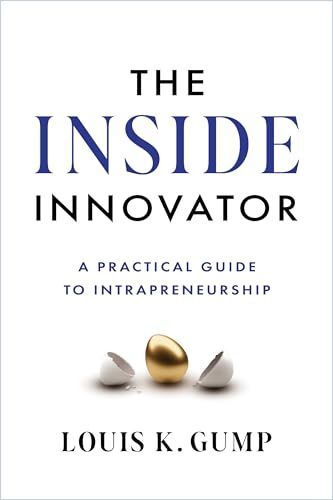Louis K. Gump, former CEO of Cox Media, lays out the path to success for “intrapreneurs” who work within their parent companies to innovate and find new sources of profit.

Intrapreneurs Can Thrive
Louis K. Gump, President of Cambian Solutions, former CEO of Cox Media — the advertising division of Cox Communications — and former board member of Mobile Marketing Association describes intrapreneurs as “in-house innovators”: entrepreneurially-minded individuals working inside a larger parent company, such as a nonprofit, global business, or government entity. These individuals lead teams that develop innovative products and services within their parent companies, such as, for example, the successful development of a mobile business for The Weather Channel in the early 2000s.
Intrapreneurs…are the insiders with the outsider perspective.Louis K. Gump
By acting as entrepreneurs within an existing company, intrapreneurs help large organizations stay innovative, adaptable, and profitable. They also can reveal potential in-house profit centers that leaders may have overlooked or never knew existed.
Intrapreneurs are curious, action-oriented, and at ease with connecting and collaborating. You don’t need to be an expert in all areas; your team can help with the rest. And you don’t need outside capital — your parent company funds your activities.
Gump suggests that would-be intrapreneurs start by examining their parent companies and the external marketplace, looking for growth opportunities that warrant a team’s full attention.
Understand your parent company’s current business strategy and find ideas to accelerate trends, he writes. Determine the practicality of your intrapreneurial idea within your parent company. Consider the company’s needs, priorities, and risk tolerance levels. Undertake empirical research with customers and general research on the market.
Next, craft a plan showing why your parent company should support your idea. Define your vision, goal, and values. Your vision must be an evergreen, aspirational statement, Gump notes — like LinkedIn’s “Create economic opportunity for every member of the global workforce.” Your goal is a simple sentence defining your desired outcome and its positive effect on the parent company. Your values are single words — such as integrity, curiosity, or respect — that will guide you and your team. Articulate how your idea will serve your company’s interests.
A Diverse Team
Build a diverse team in which people’s skills and attributes are complementary. Gump suggests hiring introverts and extroverts locally and internationally, with a mix of age ranges and life experiences. Gen Z workers, for example, tend to have a strong entrepreneurial spirit and engage with innovative projects.
It’s incumbent upon the team leader to ensure that the team is not only built but built to last.Louis K. Gump
Celebrate successes, communicate, and support members with coaching, development opportunities, and the ability to gain more exposure in the industry. For compensation packages, include a long-term incentive plan (LTIP) that provides team members with cash, stock, or other payouts if they reach specific goals.
Develop a communication strategy to build support, avoid delays, and address parent company concerns.
Gump recommends using the “Responsible, Accountable, Consulted, and Informed” (RACI) model to customize your communication style to varying stakeholders. For example, when communicating about a particular task, identify who’s responsible for completing it, who’s accountable for the expectations and deadlines, who should be consulted for feedback — because your intrapreneurial project will directly affect their work — and who you should inform through updates — because it might affect their work. To decide whether you should email, text, or talk to a particular stakeholder, refer to the Platinum Rule: “Treat others as they want to be treated.”
Listen with care. Understand what your stakeholders say, what they need to hear, and what your intrapreneurial project needs from the conversation. Remember, Gump writes, intrapreneurs are activating businesses within parent companies with their own expectations. You must prove viability. Involve your parent company CEO and pre-sell to new customers to demonstrate your product’s ability to generate revenue.
Gain requisite technology infrastructure by connecting with your company’s existing IT support or outsourcing to others with the necessary expertise. Iterate your way to success, focusing on serving your customers, team, and parent company. Your process will include failures, but these serve as necessary catalysts for more significant growth. For example, ESPN’s early Mobile ESPN venture, which failed in 2006, showed ESPN how to take that idea forward in new ways.
Join and participate in relevant industry organizations like the Mobile Marketing Association (MMA). These organizations help you source new talent, find development opportunities, discover new trends, and network. Be discerning about which organizations you join and how much time you commit. Your intrapreneurial project should always be your first responsibility.
Give Back
Give back to improve your team, parent company, and broader community. Find ways your team’s strengths can fulfill community needs. For example, during the COVID-19 pandemic, Cox Media allowed local businesses to run ads in space they usually set aside for big companies.
We remember the people who show up for us. We know they gave us something and considered us a worthy member of their community.Louis K. Gump
Partner with schools to provide unique educational opportunities, Gump writes, or include interns on your intrapreneurial team. Help team members unlock their full potential by considering what they need to reach their goals and supporting them. For example, if a product manager on your team wants to pursue a business development career, find relevant assignments for that person to take on in addition to intrapreneurial duties.
Review
Louis K. Gump played a hands-on role in breakthrough business discoveries at a time when mobile opportunities were the hot topic of the day. This might explain why he offers few concrete examples of contemporary or likely future intrapreneur opportunities. Still, Gump’s text is a terrific starting place for those with an entrepreneurial bent who wish to pursue their ambitions without leaving their current employers. Gump’s simple writing suits his book’s straightforward structure and ideas. For readers new to the concept of intrapreneurship, Gump offers a sound introduction.














